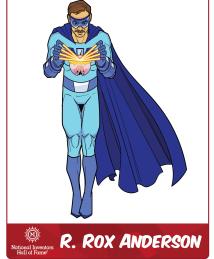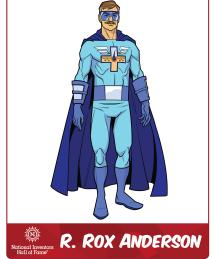R. Rox Anderson
"I think everybody is born with curiosity. It’s a question of whether you hang on to it."
Physician Rox Anderson developed laser-based treatments and procedures now commonly used in medical care to remove birthmarks, scars and other skin lesions. Anderson’s groundbreaking laser technology also advanced laser-based solutions for other concerns, including permanent hair removal, acne treatment and tattoo removal.
Anderson was born in Champaign, Illinois, in 1950. Growing up, he had plenty of freedom to explore, experiment and invent his own ways to have fun. “On the prairie, lots of little adventures can be had,” he shared in a conversation with the National Inventors Hall of Fame®. “I learned how to sail my bicycle, for example, because the land is absolutely flat. If there’s a good breeze, you could put up a makeshift sail and go for 100 miles.”
Anderson and his friends also found fun in electronics. They modified rocket-building kits and took apart discarded radios and other items so they could experiment with the components and design new circuits. By age 12, Anderson had become an amateur radio operator, and he was thrilled to be able to contact people across the globe.
“I think everybody is born with curiosity. It’s a question of whether you hang on to it,” Anderson said. His enduring curiosity and drive to solve problems led him to the Massachusetts Institute of Technology, where he earned a bachelor’s degree in life sciences in 1972. He then earned his medical degree from Harvard Medical School in 1984.
In 1980, during his studies at Harvard, Anderson discovered a study on argon laser treatment for port wine stains (PWS). Though effective, the treatment carried a high risk of scarring. Anderson’s quest for an alternative led to the idea of selective photothermolysis (SP), which stemmed from his theory that by using pulses of light at appropriate wavelengths, specific structures within skin could be targeted and destroyed without damaging surrounding structures. Anderson developed SP with Harvard colleague John Parrish, then worked with Candela Corp. to produce the first commercialized pulsed dye laser. SP proved a landmark concept, successfully addressing PWS and forming the basis for many other dermatological laser treatments.
With his colleague Dieter Manstein, Anderson developed fractional photothermolysis, a procedure that rehabilitates hypertrophic (raised) scars using microscopic laser beams to initiate a natural wound healing response with no additional scarring. Anderson and Manstein also invented and developed selective cryolipolysis, which uses cold to selectively remove unwanted body fat. Cryolipolysis is now popular worldwide as a noninvasive alternative to liposuction.
Anderson continues to be driven by his curiosity and willingness to help others. In addition to contributing to treatments for vocal cords, kidney stones, glaucoma, heart disease, photodynamic therapy for cancer and optical diagnostics, since 2013 he has established charitable medical treatment facilities in several countries. To ensure these facilities’ self-sustainability, he has contributed his expertise to train local physicians.
When asked to describe himself in an interview with the National Inventors Hall of Fame, Anderson responded, “I like to solve problems and I care about other people, and sometimes that gets expressed by solving problems in a lab, inventing and making technology work for people. I think of myself as a problem solver.”
Named on more than 80 U.S. patents, Anderson is the recipient of numerous awards. His laser technologies have been licensed to multiple companies, and he persists in researching both laser and nonlaser applications for medicine. He currently serves as the Lancer Endowed Chair in Dermatology at Massachusetts General Hospital.
Anderson said of his passion for making a difference for others, “My greatest pleasure is knowing that I’ve really helped somebody else. And who is the somebody else? It could be anyone.”


